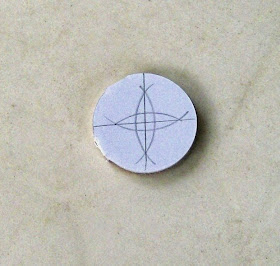My Necchi Lelia was giving me some loose stitches yesterday. Adjusting the upper tension and presser foot pressure had no effect, so I pulled out the bobbin case and checked the tension on it. I have a spring tool that supposedly tells the proper upper and lower tensions
but I have used it before and am not happy with the results.
Tension always seems way too tight after adjusting to the tool's marks.
I read somewhere on the internet that proper Class 15 bobbin case tension could be found by filling a bag with just under 1 1/2 ounces of sugar and hanging that bag of sugar from the bobbin thread. Not wanting to keep a bag of sugar around to invite ants, I opted for a bag of metal washers instead.
I broke out my cheap-o balance scale
and measured out 1 1/2 ounces of washers and put them in a zip-lock bag.
Adjust the tension screw on the bobbin case until the bag of sugar slowly drops. If the bag stays suspended, tension is too tight; if the bag drops like a rock, tension is too loose.
When you have the adjustment just right, re-insert the bobbin case in the machine and adjust upper tension to achieve a balanced stitch.
I adjusted the Lelia's bobbin tension until the bag dropped slowly and put the bobbin case back in the machine. Stitches were ALMOST perfect, maybe just a tiny bit tight - I had to increase upper tension to '5' to balance the stitches but it gives me a starting point. I will remove washers from the bag one-by-one until I have a measuring device that gives me the result I want.
My next thought is to use some of that left-over spring wire to make a homemade tension scale.
Ed
























